Friendship begins with a moment of mutual trust.
I knew that moment had come when Tako sat on my hand.
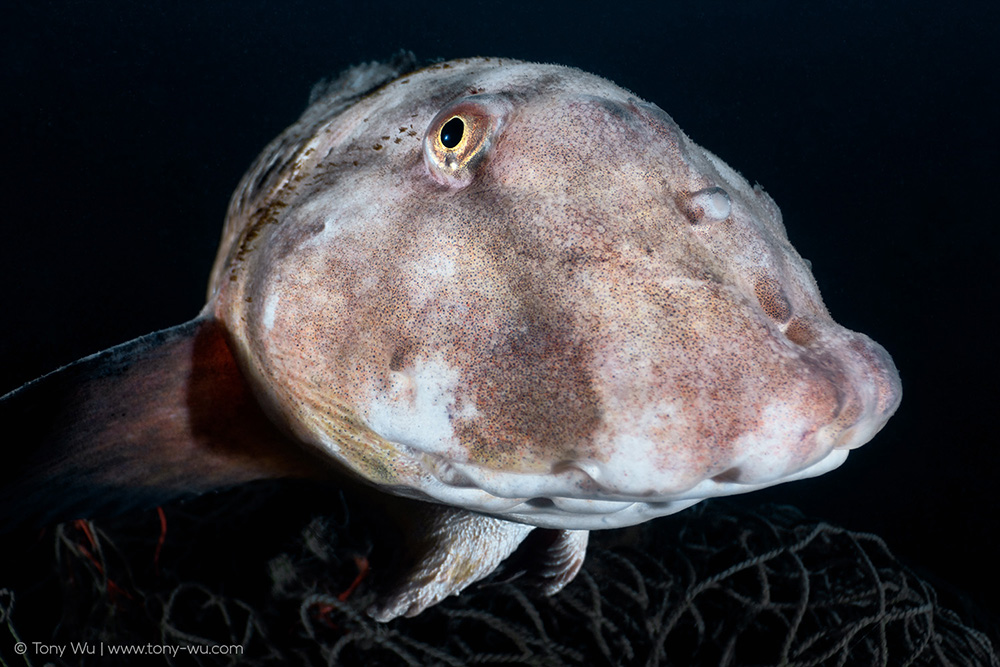
Liparis tanakae snailfishes are homely. Their faces look kind of like one of those puppets you made as a kid, using a ratty old sock fitted over your hand, with googly eyes and dorky smile inked-in with a black marker, the kind that leave the tips of your fingers stained for days no matter how much soap you sacrifice. When they swim, the fish don’t slice through the water in the manner of a streamlined barracuda. They don’t flit about as delicate fairy basslets do. They levitate. Think of a dirigible like the Goodyear blimp, one with just enough lift to wobble off the ground, one that happens to have a tail that flutters like a windsock, albeit with controlled, rhythmic undulation. A floating windsock with a purpose, if you will.
When Tako and I met in January 2024, his mission was clear—claim and conquer prime real estate; impress the ladies; make lots of babies.
“He was being friendly,” I said to my friends. “He kissed me and sat on my hand!” The look on my face was a mix of sincerity and desperation. I really meant what I said; I really wanted Tsutomu and Miki to believe me.
No words were exchanged for a very long brief time.
“Uh huh,” was the implied response, conveyed not just by the silence, but also by the oh-dear-poor-deluded-fellow expressions on their faces.
Tsutomu and Miki run a dive shop. 2002 was the first time that they encountered kusa-uo (クサウオ), as Liparis tanakae snailfishes are called in Japan, at a location they had just started visiting the year before.
The bay is nondescript, remote, tucked away in a corner of a small island at the back end the country. The local economy revolves around farming, fishing, some tourism. As is the case in much of Japan, the population is aging and declining. Many of the buildings and other structures are weathered, tired. They have seen better days. Most areas of the hotel where I stayed during my first visit had been closed off. A fire had ravaged 80% or more of the structure. What remained was a handful of rooms on the ground and first floor, along with a run-down cafeteria furnished with long fold-out tables, metal chairs, and tall glass-paned refrigerators stocked with tea and milk, but mostly beer. The table coverings were vinyl, no doubt to ease the wiping up of spilled beer. There was a reception desk. No one was ever there.
Any place else in the world, the dilapidated facility would have been condemned, closed. But the eccentric elderly proprietor was adored by all. He loved to entertain. Local lore says that he came from wealth. Stupid rich wealth. As a young man, he had plowed all of his money into building a grand facility. The ruins where I stayed were all that remained. People looked the other way and let him carry on regaling visitors with tales of glory days over drinks. Lots of drinks.
At night was a cacophony of sound—the courtship calls of amorous frogs, mostly Japanese tree frogs (Dryophytes japonicus) I think. There are undoubtedly many more frogs than people.
To access the bay, you unload gear at the side of the road (there’s only one), lift everything over the side wall and pass stuff to someone on the other side to lower to the rocky beach 2.5m below. Easy for masks and snorkels. A chore for scuba tanks, heavy cameras and such.
Calling the area a beach is perhaps a bit misleading. It’s more like a pile of rocks, dirt and unfortunately plastic as well aggregated in a corner. The area is small, much more so at high tide, and it is sloped. Balancing can be tricky, depending upon where you are situated. Upright scuba tanks can tip over with ease, particularly when it's crowded. From here, you suit-up and walk into the water.
The first thing you see is brown. Lots of brown. The bottom is covered with a layer of loose, mucky sediment. On weekends, when there can be dozens of divers with less-than-ideal command over limbs and movements, brown can end up being pretty much the only thing that one sees. The silt stirs up with emphatic poofs, transforming the ocean into an opaque mist.
The substrate is featureless but for discarded fishing nets. There was a fish farm. It is closed now. It operated for decades without ever turning a profit, dependent upon government subsidies. When they finally shut down, the facility ditched nets in the ocean. Piles of them. Those original nets are gone of course, long since degraded, but for the sake of tradition, local fishermen continue to dump nets here.
It was on one of the original piles that my friends stumbled upon snailfishes over two decades ago. The mountain of nets was large. On it were two snailfishes watching over clutches of eggs.
It was 29 January 2024, Monday morning.
I was alone. Tako was alone.
This moment was something like 18 years in the making. I do not recall the exact date when I began researching Liparis tanakae, but I know that it was around the time that I relocated to Japan. That was 2006.
This being the first time that I’d been alone with a snailfish, I approached his nesting area—a pile of discarded fishing nets—with caution. I stopped two to three metres away, settled on the bottom. My camera gear was folded-up, idle. I wanted to assess the fish’s reaction—note body language, look for signs of anxiety, irritation.
Tako looked at me, rose up in the water column, swam toward me. Straight toward me. Non-stop. Right up to my mask. And kissed me. Leaving me—as you might imagine—unsure about how to interpret this unanticipated turn of events.
I should probably explain why I am calling this fish Tako.
I was unable to take photographs of Tako during that first meeting. He was always too close. By close, I mean rarely even 10cm away. He nuzzled me, explored inside my BCD, sat on my head, and eventually sat on my hand when I held it out to see what he would do. I prepped my camera and tried to take a photo. When I did, he put his face on the lens. I leaned back to open up some distance. Tako leaned in to close that distance. I leaned back. Tako leaned in. We repeated until I fell flat onto the ocean floor, snailfish hovering above with what might have been a look of concern. Scratch that. He wasn’t concerned. He was laughing.
When I did finally manage to take photos, I noticed a couple of circular, white patterns on the fish’s right pectoral fin.
See them?
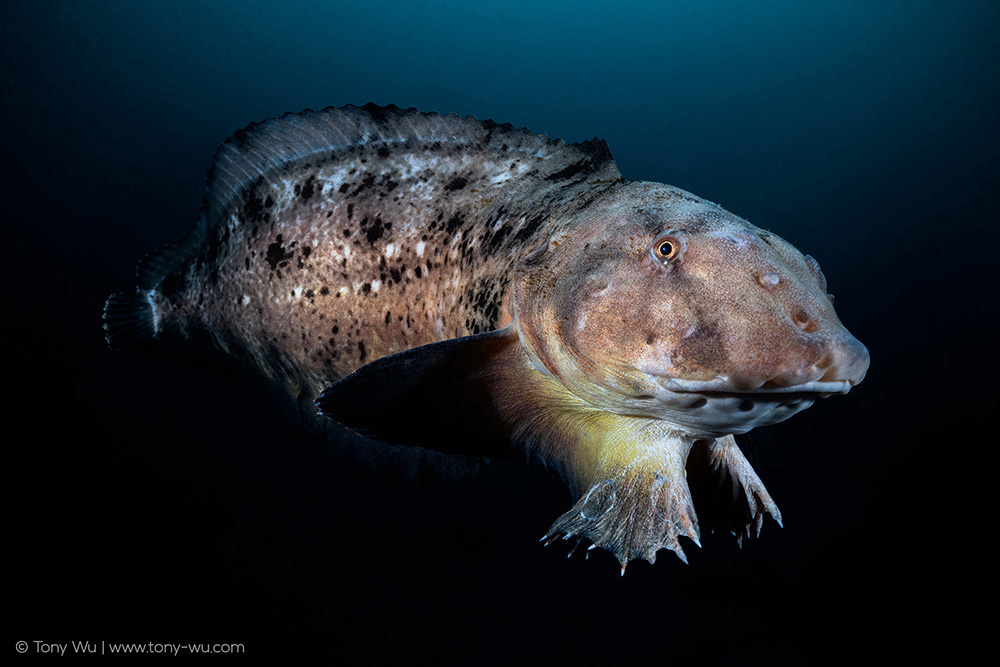
I examined photos of other snailfishes. No circular marks.
I asked Tsutomu and Miki if they’d ever seen anything similar. They had not.
I puzzled over this late into the night. Until it hit me.
Snailfishes spend their lives in deep water. Exactly how deep depends upon the species. Some types live waaaaaay down there. According to the entry in Fishbase, Liparis tanakae snailfishes are found at depths of 50m to 120m or so. Deeper than scuba divers normally visit, in other words.
Octopuses are also found in these waters, at all different depths. I was thinking specifically of giant Pacific octopuses (Enteroctopus dofleini), but there are undoubtedly many other types around. The scars look remarkably like the shape of cephalopod suckers.
I searched for information about whether snailfishes hunt octopuses or vice versa, but was unable to come to any definitive conclusion. There does not seem to be much information available about the lifestyles of Liparis tanakae. I don’t think they hunt octopuses. Maybe an octopus tried to grab Tako. Whatever the case, the most straightforward explanation for those scars seems to be an encounter with a large octopus.
The word for octopus in Japanese is tako, pronounced much like the Mexican dish. I dubbed my new friend Tako-kun. The suffix -kun connotes familiarity, endearment and the like in Japanese. You’d use -kun with close friends, for example.
The name stuck. Tako-kun became a local celebrity.
Tsutomu is a man of few words. Polite and soft-spoken, he says only that which need be said, not a word more. When Tsutomu finally replied to my silly declaration, he said, “The fish was being aggressive. Not friendly.” His expression spoke volumes.
His response—in all fairness—made total and absolute sense.
Mature snailfishes like Tako visit the shallows for a singular purpose—to reproduce. Not to play with camera-toting interlopers.
And yet, there we were. Fish on a mission. Me on a mission. Playing.
Faced with such scepticism, I asked my friends to take a look for themselves. Both Tsutomu and Miki were attending to clientele. They did not have time to go see Tako-kun with me, but their diving clients always ran out of air long before I did, so there was time at the end of their dives after my friends had returned their guests to shore.
This is a sample of what they saw, Tako and me saying it-was-fun-hope-to-see-you-again-soon (video courtesy Tsutomu and Miki):
The moment we surfaced, Tsutomu shook his head and remarked, “I can’t believe it. That is definitely not aggression. He is actually being friendly.”
The morning that we met, I actually thought that I already knew Tako.
I had visited Tako-kun’s nesting site two days prior, on Saturday the 27th. That was my first day in the water. There were a few other divers with us, and there were several dozen people with other dive operators. It was crowded.
My objective during peak weekend traffic was to ensure all my gear worked and figure out what I wanted to do and where. I tagged along with the group, observing from behind, making mental notes, asking questions later. I took a few photos, primarily as reference material.
There were four nesting sites, more than there had ever been. Tsutomu and Miki explained each location, telling me how long the male had been there and describing its personality.
Yes, fishes have personalities. A given fish is not going to register as INTJ on a Myers-Brigg type indicator, but each individual will have a unique temperament. Most times, these nuances are difficult to discern. You meet a fish and bye-bye-see-ya-later that’s it.
At spawning time however, there is often the possibility of having repeat encounters with a given individual. In stable situations like this, individual traits can become apparent. Some fish have nothing but contempt for bubble-blowing blowhards. Some don’t seem to care one way or another. Some are inquisitive. Some are shy. Some attack any fish (or sometimes person) that comes along. Some don’t.
Four dives during the course of the weekend was enough for me to decide. I would concentrate on the site that ended up being Tako’s. It was relatively deep—18m-ish depending upon tide—and reasonably far from the entry point. The distance and depth reduced the chances of interruptions. There was a deeper site farther away, but the potential aesthetics didn’t appeal as much.
By Monday morning, the crowds were gone. I went to my chosen site. The male was swallowing eggs by the mouthful. Chomp. Chomp. Chomp.
“WHAT the heck?” I thought. “Why would a male eat his own eggs?”
I watched as he scarfed down a quarter to a third of the eggs. The process was quick.
My understanding from Tsutomu and Miki was that the male concerned had been at that site since 22 January, a week before. Mature male snailfishes, you see, have limited time once they come up to the shallows for spawning. They don’t eat (or perhaps, there is nothing suitable for them to eat?). They compete for nesting sites, often engaging in physical battles. The ones that succeed in securing nesting sites then expend energy to attract females, spawn as often as possible, and defend their sites from other males that want to take over. They also clean the nests and eggs to keep them healthy.
According to my friends, successful males preside over nesting locations for ten days or so. Then they die or are vanquished by a challenger. And then die. The metabolic burden takes its toll.
The result is a continuous chain of males that command a nesting site. Although this sorta sucks for a given male snailfish, it makes sense from a population standpoint. Males compete, the fittest at the time prevailing. They spawn. The next male comes along, vanquishes the guy who is already there, then spawns. And so forth.
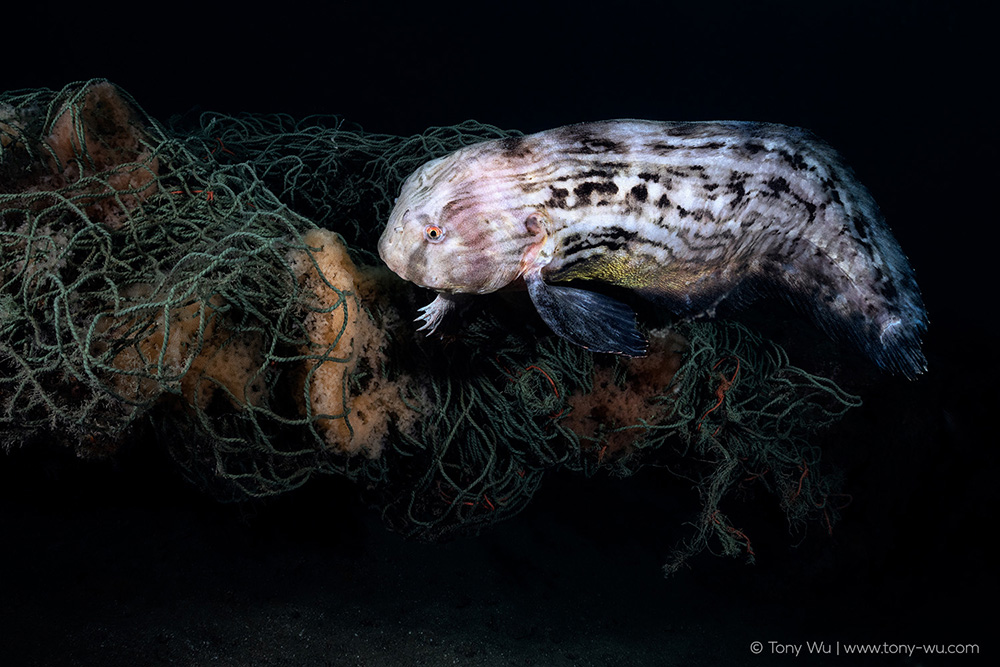
You end up with a lot of eggs of varying developmental stages and pedigree clustered together, always with a strong, robust male keeping them clean and safe. The mixed parentage ensures diversity of genetic material, optimal for ongoing success of the species.
When I had visited this spot just a couple of days earlier, I saw a male sitting on the eggs, the one pictured above. He swam out in warning if someone got too close—doing what one would expect of a male snailfish making the most of the time he has to pass on his genes.
This is the same male that I thought was there when I went back to the site alone on Monday.
But why would he be eating the eggs?
It was in this state of confusion that I settled on the bottom that initial visit, when Tako swam out to kiss me after consuming so many eggs.
Given how preoccupied I was at the time with Tako-kun’s affections, I forgot about the egg-eating until after the octopus-scar light bulb went off.
Tako wasn’t Tako!
Meaning that the fish that I had just named Tako and the one that I had seen on my first day of diving were probably different males.
A few minutes of sorting through images and I was certain.
At some point between my initial dive on Saturday and my first solo visit on Monday morning, Tako had taken over. The other male—which had looked plenty healthy to me when I saw him—was nowhere to be seen.
Snailfishes reproduce during winter. They did so in the bay each year from my friends’ first encounter in 2002 through the winter of 2014. Then they stopped. Or were stopped. Depending upon how you view it.
Based upon Tsutomu’s and Miki’s experience, it seems the fishes need water temperature in the shallows to be 12ºC or less. This is the line below which the fishes get their sexy on, above which there is no hanky-panky. Timing is critical as well. The water temperature has to drop at just the right time. A few weeks too early or late might not work. The temperature has to be sustained. A few hours of 11ºC, followed by days of 13ºC won’t cut it.
Even if conditions aren’t suitable though, snailfishes still come up from the deep. They just won’t spawn.
This is what happened from 2015 onward. That year happens to be exactly when I set my mind to photographing snailfish reproduction. Though I had kept track of the fishes' annual appearances for nearly a decade by then, cold water had served as a deterrent. Toward the end of 2014 I resolved to suck-it-up-buttercup and give it a try.
But nature had other plans.
Each winter between 2015 and 2022 (I’ll get to 2023 in a moment), snailfishes came up, hung around, and died. Conditions weren’t suitable. Baby snailfishes were not made.
In some years, the snailfishes died of natural causes. Their time simply ran out.
In 2020, there was hope of reproduction. There were many individuals, including females plump with eggs. The water temperature dropped. Expectations were heightened. I was poised to travel. Fishermen entangled all of the snailfishes in nets. It was carnage.
The message thread each year with Miki went something like this:
“Have the fish arrived?”
“Yes, but not many yet.”
A couple of weeks later, “Has there been any spawning?”
“No. Most of them are dead.”
Sigh.
In 2023, I waited until late January. Things were looking the same, so I committed to a different location. Mere hours before I departed, Miki sent me an urgent message: “COME NOW! THE FISH HAVE SPAWNED!!!!”
Having already made arrangements with other people in another place, I was stuck.
It was painful to receive progress reports. I had waited nine years and blew my chance at the last second. Numbskull.
With profuse apologies to Tsutomu and Miki, I pledged to wait the following winter, come what may.
For ten days, we followed a routine.
I visited in the morning. Tako-kun greeted me. We interacted as much or as little as he wanted. Then I’d photograph.
Some days were sitting days. He’d perch atop his nest. I’d settle next to him. We’d make eye contact, contemplate one another, ponder what it was like to be the other.
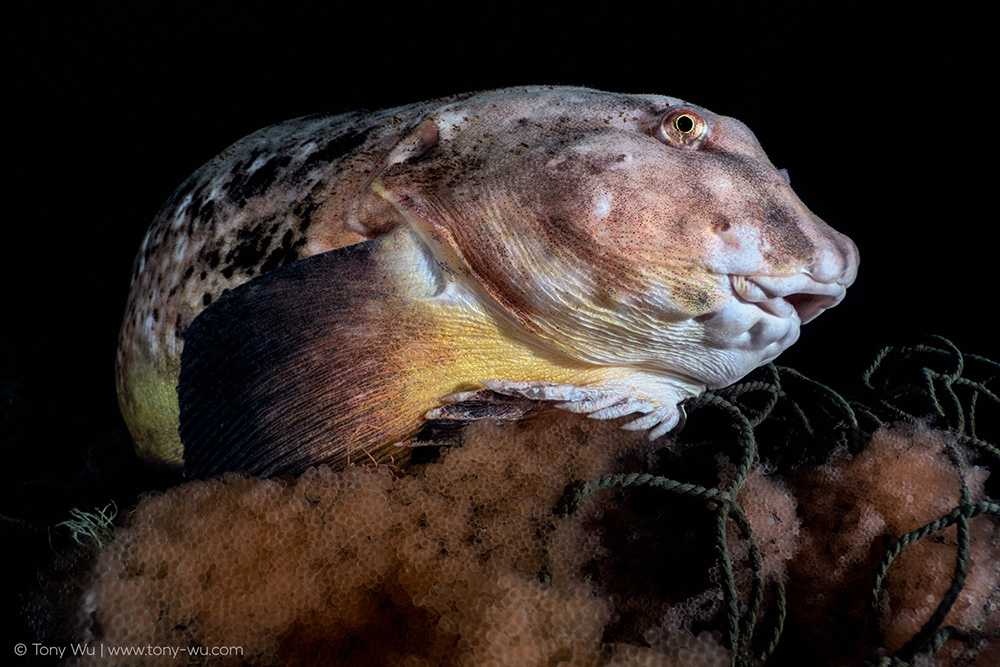
On other days, he’d be in the mood to noodle about, survey his domain.
It was at times like this that I had the opportunity to look. Really look.
Each Liparis tanakae egg is around 1.5mm in diameter, just under that for every egg I sized using pixel count.
Examining such minuscule bundles poses a number of challenges.
It is difficult to locate anything through a camera viewfinder at high magnification. It is equally difficult keeping your subject in view once you find it. The smallest movement results in enormous changes. Depth of field (how clearly you can see stuff behind and in front of whatever you’re focused upon) is super-duper-restricted, so if you lean forward a fraction of a smidgeon, whatever it was you were looking at becomes an amorphous blur. Put on a pair of eyeglasses with coke-bottle thickness and attempt to find a quarter of a sesame seed in a pile of hundreds of quartered seeds and you’ll see what I mean. Now try that underwater while being pushed around by an irregular ocean swell.
The way diopters work, your lens needs to be close to the subject, meaning that you have to be careful about when you move and how you do so. Too fast, too much and you can wreak havoc.
Finally, when you actually succeed in pinpointing a subject, focusing and framing it, pressing the camera trigger too quickly or with excessive force can introduce vibrations which—pay attention to this technical explanation—screw everything up big time. That’s not even mentioning the irritations that accompany efforts to illuminate such small subjects in an eye-catching manner.
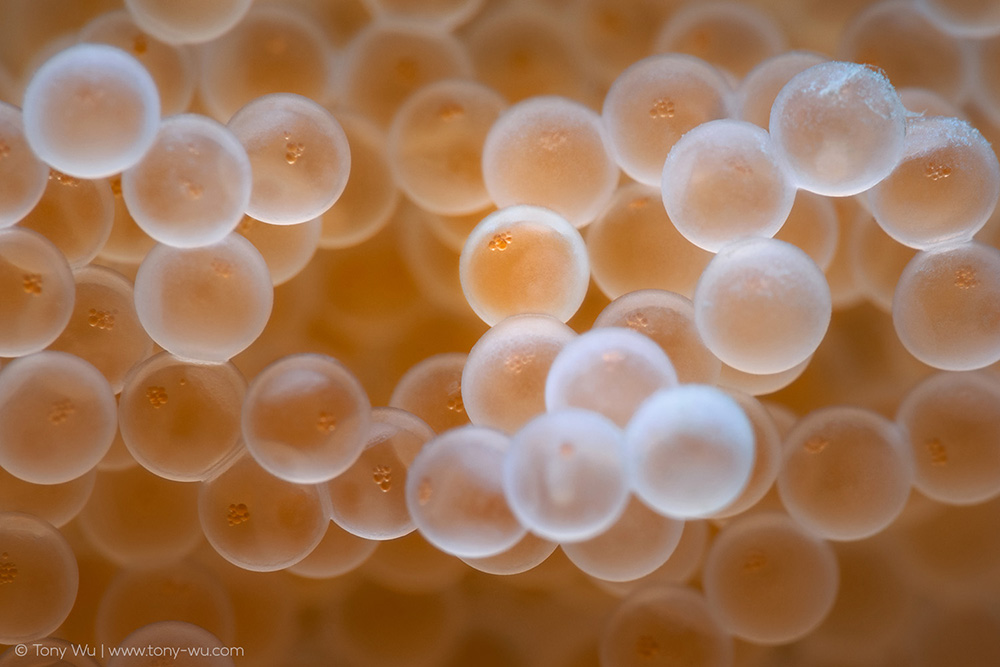
I share this with you not to burden you with my troubles, but to point out that the only way that I was able to engage in the process I described is with the permission and full cooperation of the guardian, Tako-kun.
Hunched over, squinting through the viewfinder with intense concentration, I’d often feel my right shoulder get just a bit heavier. Sometimes my left, or my back, my head even. But it seemed most often to be my right. That is where Tako liked to sit, to look at me looking at his eggs. Whenever this happened, I turned, acknowledged Tako. He acknowledged me in return. Then I’d go back to squinting at eggs. Tako would go back to looking at me.
By day three of our friendship, this state of affairs seemed completely normal.
Then Tako showed me that it wasn’t.
Another diver came to the site. I moved aside to give him a chance to see the snailfish and eggs.
The moment that person approached Tako lunged. The message was unequivocal. There was a line. No crossing of that line. Period.
The diver departed. I approached with caution. Tako didn’t bat an eyelash. I resumed examining eggs. Tako resumed looking at me.
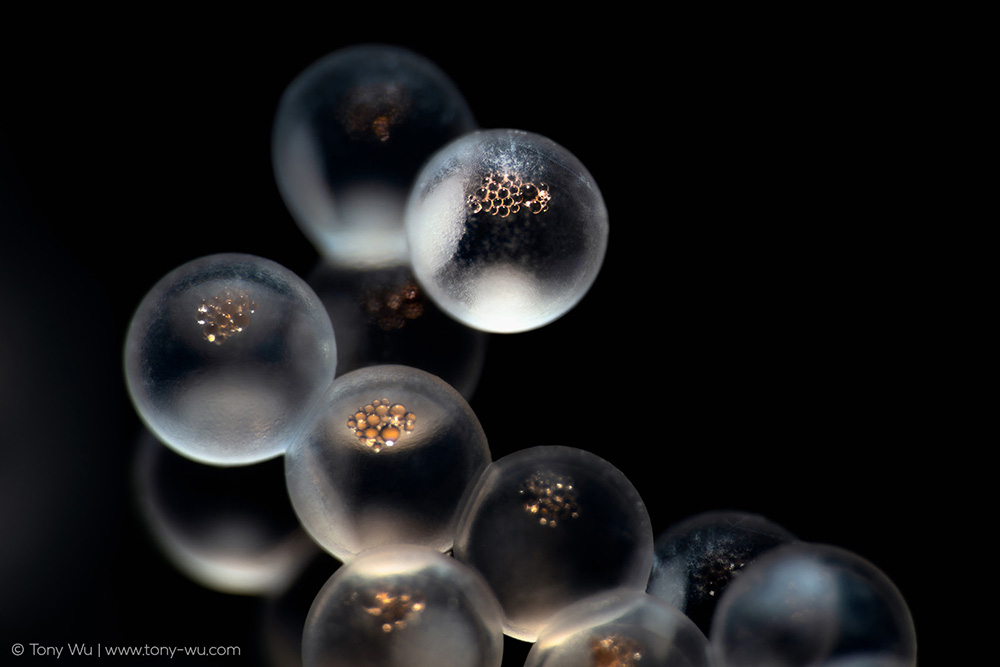
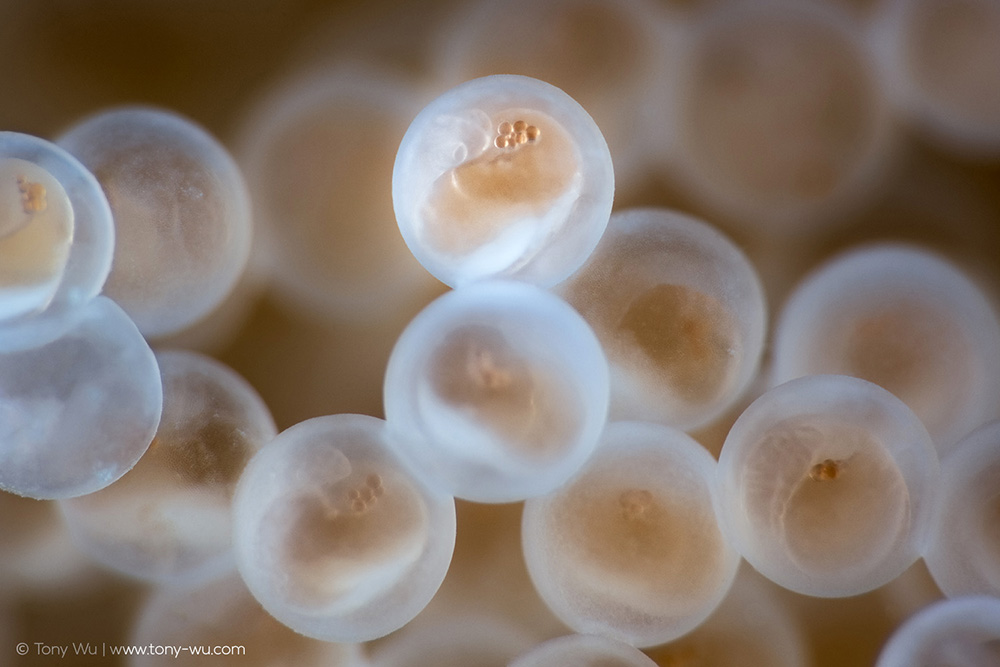
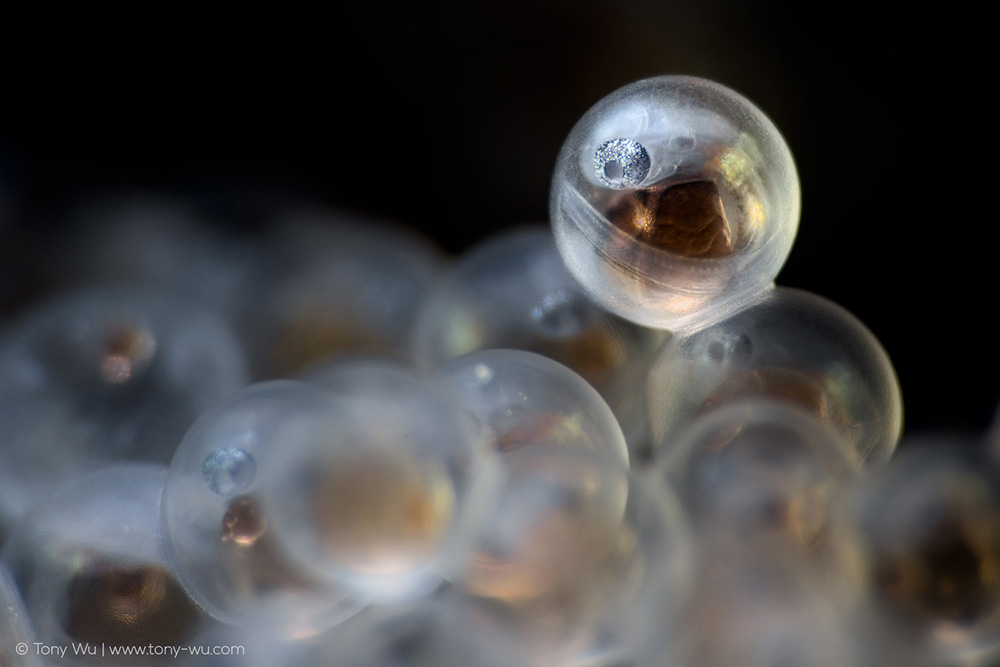
Thanks to the access and time that Tako granted me, I was able to find eggs at different stages of development, ranging from just-spawned to early, mid and late stages of development.
Of the thousands of eggs that I scrutinised, one stood out:
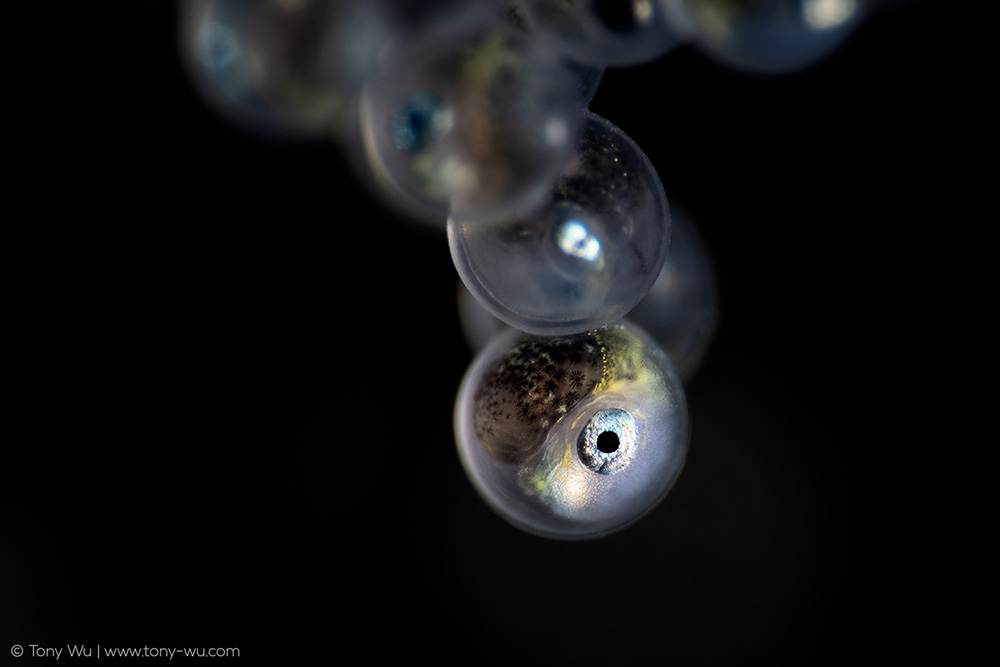
Hanging down from the main cluster, this egg was situated in front of an area that had once been packed with eggs as well. Tako-kun had consumed them on the day we met.
In photographic terms, this translated into the possibility of isolating the egg. Distracting visual clutter was still there, but with the correct lighting, I could conceal it. I could show you just the egg and well-developed juvenile inside against a backdrop of monotone negative space, so you can marvel just as I did.
I returned to this spot day after day.
“It sure would be nice to see this fish hatch,” I thought. I knew that the chances were low. There is no way to predict when the little ones launch.
And even if the juvenile were to emerge while I was present, the probability of having my camera in the correct position with lens focused on the relevant sliver of a millimetre at the exact fraction of a split-second was as close to zero as one can get.
Just as I was wallowing in the futility of it all, my finger moved. I hit to review button to see the birth of Baby Tako:
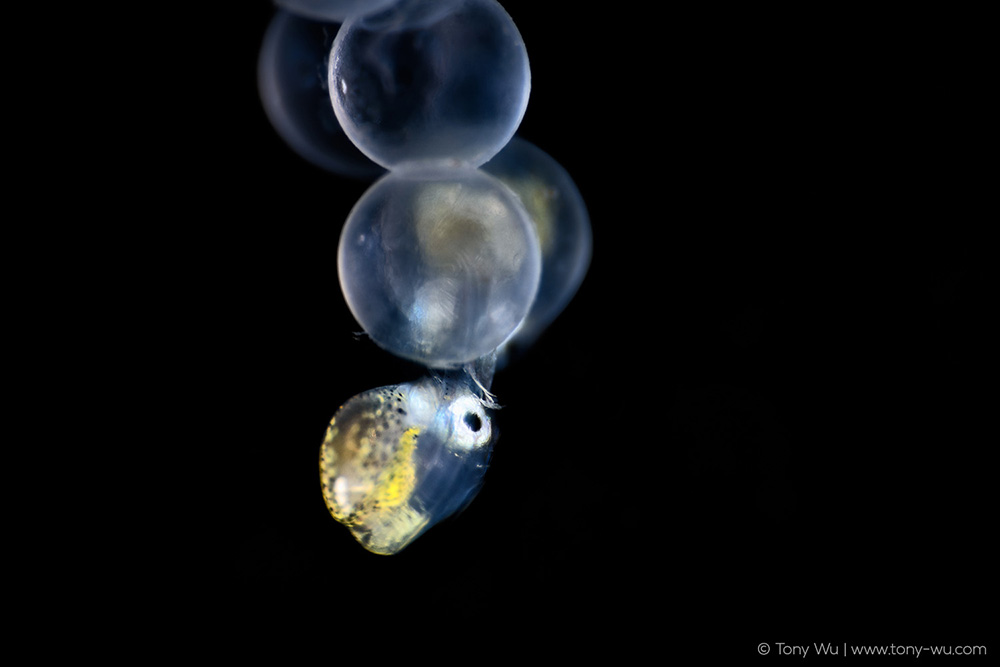
The juvenile had just squirted out like the inside of a squeezed grape. Its caudal area was still within the egg casing. Incredibly, the eye of the fish is in focus.
I’d like to say that I was poised and alert, in full control. That I reacted with speed to put lightning to shame. That it all went according to plan.
But we all know better.
At some point, my eyes and fingers had a meeting.
“Look, if we let this brain thing stand between us, we’re screwed. We gotta cut the middle guy out. We signal, you trigger, got it?”
“Roger that.”
My brain is still befuddled.
Tako was popular with the lady snailfishes. Clusters of newly spawned eggs appeared often. I never saw him spawn though.
I only saw attempted-and-failed courtship by another male, at the deeper, farther site I referenced earlier.
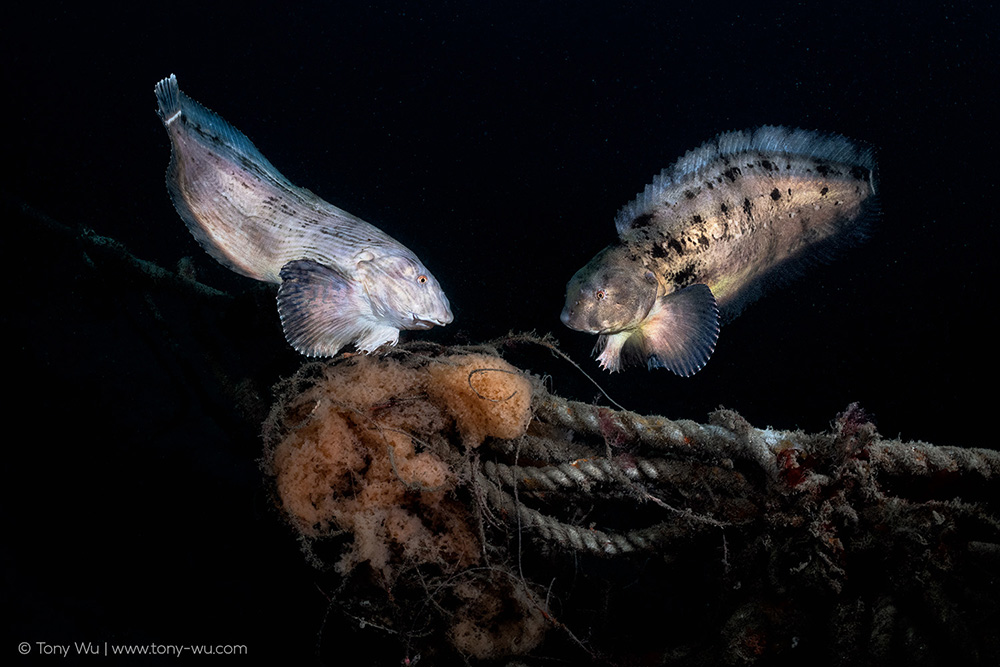
The female on the left had just approached. The male leapt into action like an excited Labrador retriever. He puffed up, flared his fins to look (I assume) as snailfish-chic as possible. He pointed his nose at the spot that he wanted the female to check out.
She looked.
She left.
The male fizzled to the ocean floor like a spent balloon.
At this point, we should all refrain from drawing obvious but non-scientific parallels to people in general or to your own personal experiences. We’ll have none of that.
Tako was special in many ways, besides the fact that he chose to accept me, welcomed me to his domain.
I mentioned earlier that Tsutomu and Miki said dominant males tend to last only ten days, give or take, for understandable reasons.
Tako lasted at least 47.
I photographed him for the first time on 29 January. The last time he was definitively seen was on 15 March. It is possible that Tako was around a little bit longer. He may have already been at the site on 28 January. I did not visit the site on that day. It is also possible that Tako was still around on 16 March. No one dived in the bay on that day. All we know is that Tako was not at his nest the following day. There was no sign of him, or of any other male. Spawning season had ended.
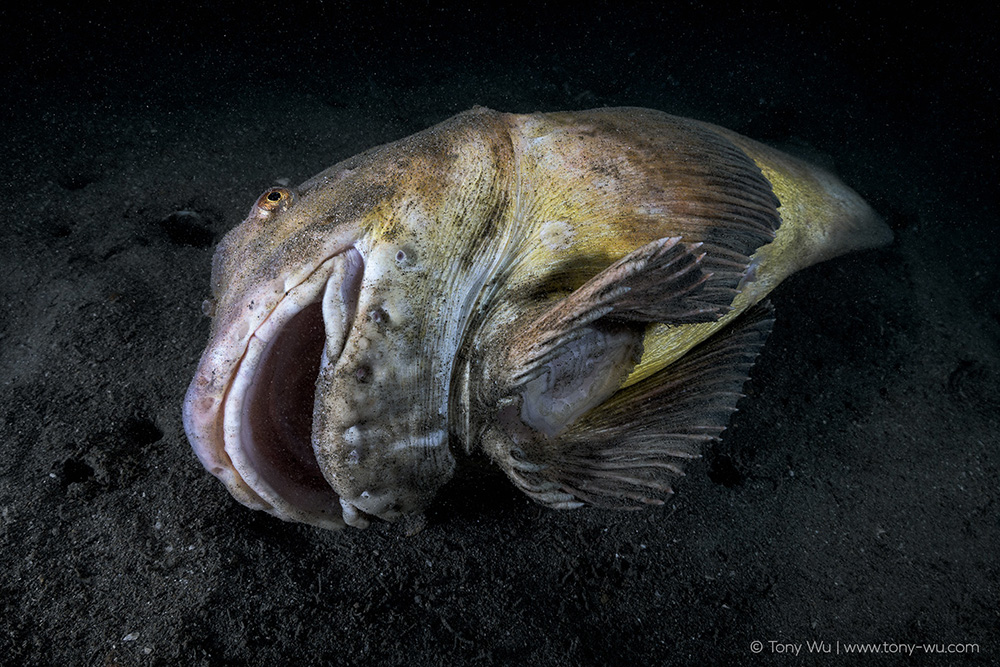
To be fair, no one has paid such close attention to sex life of a single Liparis tanakae snailfish in this manner before, as far as I am aware at least. It is certainly possible that there have been previous examples of long-lived breeding males.
The one thing that makes me think Tako-kun might have been special though, is chomp, chomp, chomp.
Recall that when I met Tako, he was consuming eggs. That perplexed me. In hindsight though, it might make sense.
Snailfishes like Tako live for one year. In that time, they grow from a few mm to 40-60cm. They live fast, but also die young. When adults migrate from deeper water to the shallows to spawn, they know it is a one-way mission. Their entire focus is reproduction. As far as anyone knows, the fishes do not eat. Their store of energy is limited.
By consuming a large number of eggs that were already at the nesting site when he took over, Tako refueled. He super-charged himself with high-energy, high-calorie food BEFORE he spawned. He consumed the eggs of others, not his own.
There is some possibility that egg-chomping is a frequent strategy. But Tsutomu and Miki have not seen or heard of it before. I know of no one else watching these fish during spawning season, so there isn’t enough information to know.
There is one other possible consideration.
Other males swam a lot, some almost continually. With zero or near zero caloric intake, every bit of energy is vital.
Tako liked to sit.
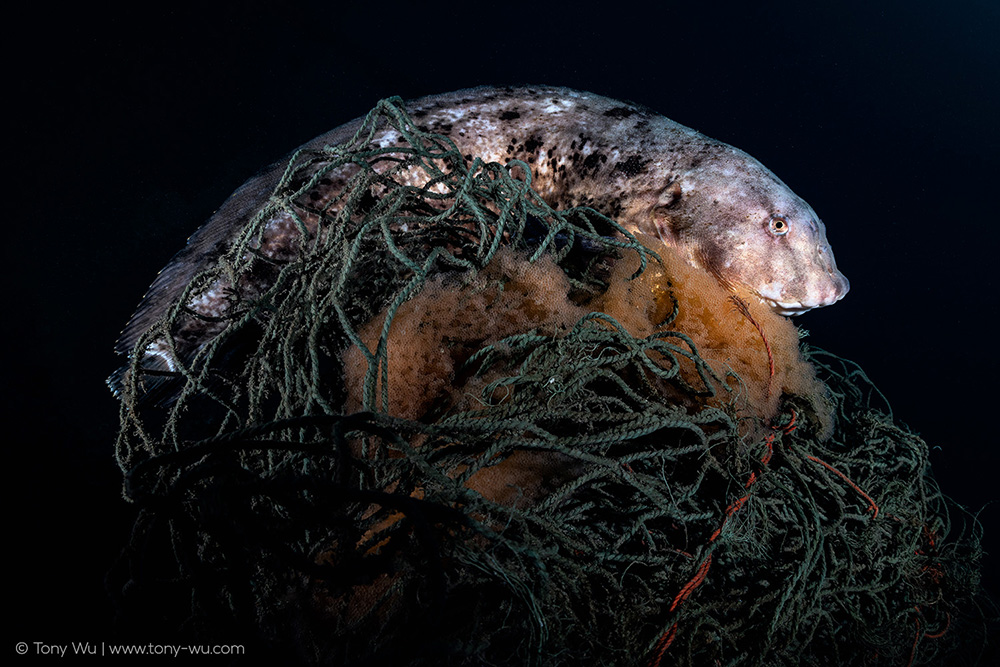
I’d like to think that he sat because he liked sitting with me, but it is more likely that he was conserving energy—whether by chance or with the specific intent to do so.
Infuse a fish with lots of calories while minimising that same fish’s energy expenditure, and he might last longer than his peers.
As Tako did.
I have had almost a year to contemplate my time with Tako. As I write this, this winter’s snailfishes have started to appear. The first spawning has taken place, which means the environmental conditions are good this season. If any of the babies from last year survived, some might be back to the same bay. Some may have ended up elsewhere. It is also possible that none survived. I cling to the hope that Baby Tako is among the returnees.
After waiting nine years for snailfishes to spawn, I missed the action in 2023 due to poor judgement. The agony of that flub stuck with me for an entire year—lots of self-flagellation. As it worked out though, 2024 ended up to being the best snailfish spawning season to date.
First, there was Tako-kun. I’m not sure if there will ever be another individual like him.
There were four nesting sites in all, versus three in 2023, three or fewer in years past. Tsutomu and Miki said there were more eggs in 2024 than ever before. This is subjective of course. There is no accurate count.
Finally, Tsutomu and Miki saw spawning take place, for the first time ever.
I was like, “Oh %$$#%I)! I want to photograph that!!!”
Then they showed me video. My reaction flipped to, “Forget it.”
Snailfish spawning turns out to be exceptionally non-photogenic.
The female rubs her belly against the substrate and deposits eggs. The male fertilises after the female leaves. The two are never together. Tsutomu and Miki have footage of three spawning events. All happened the same way.
In one memorable instance, after having presumably worked super-hard to woo a female, the male forgot to fertilise the eggs. He twiddled his figurative thumbs for 15-20 seconds before it dawned on him that he had something important to do. Men.
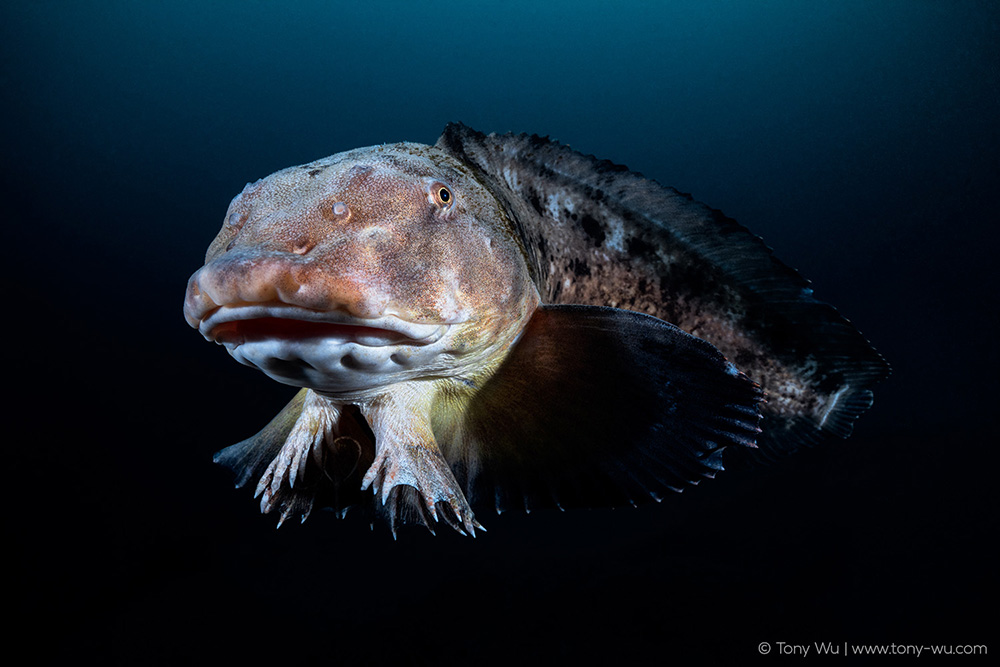
As much as I saw and learned during my time with Tako, questions remain.
Is site competition normal?
The fish clearly spawn in many other places. Their range, described on Fishbase, comprises Northwest Pacific: Yellow Sea, East China Sea, Sea of Japan, Sea of Okhotsk, Pacific coast of Japan to northern Kuril Islands.
The location I visited is mostly barren, except for piles of discarded nets. Making the reasonable assumption that Liparis tanakae did not evolve with the specific strategy of spawning on unwanted fishing gear, one has to wonder whether the reproductive behaviour is the same or different in other places.
In areas with abundant natural substrate, seagrasses and seaweeds for instance, is there a need to compete for nesting sites? Or is competition in the bay a result of artificial scarcity?
I have a feeling competition still exists, because it’s such a common feature of animal reproduction, and site competition is known among other marine fishes. But my hunch is still just a guess. I’d much rather confirm through direct observation.
Does spawning still happen as a sequential process? Female first, male later. Or is there tandem release of gametes?
I'll hazard a guess that it would make sense for the behaviour to be consistent, but things do not always make sense in the way one might suppose. Once again, direct observation is the only way to be certain.
I should note that one reason the bay is barren is that fishermen rake the bottom to harvest sea cucumbers, mainly for export I think. It happened a half dozen times or more during my stay. There aren’t that many sea cucumbers around, so it is difficult to imagine this produces much revenue. The equipment looks literally like big, heavy rakes, plowing the bottom, uprooting everything in their paths, silting-up the ocean. Life doesn’t stand a chance.
You would think we could travel one bay over and look over there. That’s not permitted. Fishermen decide who can access the ocean, when and where. This is not enforceable by law, but it is the practice in most places. So the only spot in the area that divers are permitted to enter the ocean to look for snailfish is this bay.
I’ll end by noting that Tako never interacted with anyone else as he did me. His reactions to others ranged from indifference to irritation. There was no kissing, no sitting on hands. Whatever Tako’s reasons for doing what he did, our friendship is one that I shall remember and cherish for life.
Farewell my friend. I miss you.
ars gratia scientiae